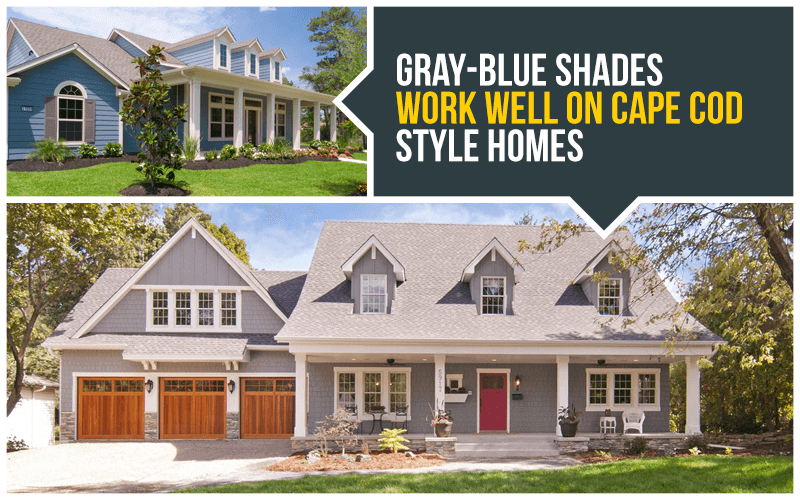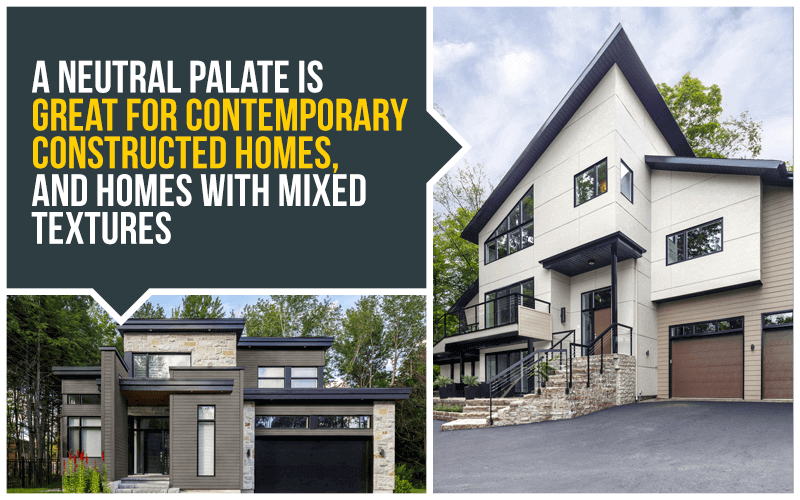Siding is the true essence of a home's exterior. While updated siding can be a big factor in boosting curb appeal and resale, it also gives your home personality and charm. Picking a new siding color and style for your home can be fun but also a bit intimidating. Homeowners should pick a color that is not only pleasing to the eye, but also a shade that compliments the rest of your exterior palette. Whether you plan to install new siding or simply repaint what is currently there, making a well thought out decision on the color you use can really pay off in the end.
If you are not sure where to start, we've outlined some tips below to help you through the selection process and guide you to finding that "perfect" siding color for you and your home.
Check Out Other Homes in Your Neighborhood
As a first step, we recommend driving around and taking a look at some of the other homes in your neighborhood. What color combinations are commonly used? What colors do you like most? Although you want to put a stamp on your siding color scheme, you also want your selection to look good in your home’s location. This is particularly important if you plan on selling your home within a few years of updating your siding. If your home stands out too much from the other homes in your neighborhood it could negatively impact your resale value.Make sure to take a close look at homes that are of a similar architectural style to yours. For example, if you have a Colonial home, you may notice that most nearby Colonials are shades of cream, yellow and gray – therefore selecting a similar color palate might be the way to go. But if your neighborhood is more eclectic, then you have a lot more wiggle room when it comes to your selection.
Bonus Tip: If you want your house to have a unique flavor without sticking out like a sore thumb, consider using shutters of a contrasting color. Shutters are easier and less expensive for home buyers to change if they don't like the colors as much.
Take a Cue From Your Home's Architecture
Most architectural styles of homes were originally built with a palette of colors that they were suited for. You can use these as an initial foundation - but you don’t need to completely abide by them:• Victorian style architecture is painted in somber colors, paying tribute to Queen Victoria who continued to wear black after her husband’s death. • Colonial inspired homes are often painted a single lighter color such as white, although unusual accents can offer a subtle, modern twist to that traditional arrangement. • Browns and warm reds are great for trims on craftsman, adobe or rustic ranches. • Cape Cod style homes work well with gray-blue shades. • Contemporary constructed homes, and homes with mixed textures work great with variations on a neutral palate. • Traditional homes look sleek in grays and grey toned-reds.
By finding your home’s “true” color palette, you can help narrow down the number of choices that will look good on it. Keep in mind that you do not have to use any of the colors in the palette if you don’t find one that suits your personal taste, but this can be a good starting point for either narrowing down your choices or for eliminating many.


View Samples and Consider Complementary Colors
There are so many different siding options out there. And while some siding options may come in a range of pre-finished colors and shades, others can be primed and painted in any color you choose. Take the time to look at pictures of homes and siding on the internet. The more colors you see, the more you’ll probably discover a pattern, such as being drawn to homes painted a particular color. If that’s the case you will just need to narrow down the right shade of that color, instead of trying to pick a color from the thousands of available options. Taking cues from your home can also be helpful and help you see how many different details your siding has. For example, if you have a lot of trim, or different types of siding such as shingles on the upper half of your home and lap siding on the lower, you may want to consider accenting these with different shades or colors. By seeing how many natural breaks there are in your exterior, it can help you determine how many colors you may need.If you’re still having a hard time with choosing a siding color, land on one complementary color that offers a bright focal point and one hue that’s a shade or two lighter or darker than your main siding color. You could use the two or three shades to update window trim, doors and railings. Complementary colors are the hues found on opposite ends of the color wheel. They tend to make each other seem brighter, and the combination generally adds energy to your look. Perhaps because of that, complementary color combinations are ones you might recognize on National Football League uniforms. On a house, complementary colors are frequently used to add drama to the look. You might, for example, introduce dark plum shutters to green Mountain Sage siding, or use muted yellow Woodland Cream to highlight the dormers on a Countryland Red house.
Check Your Favorite Paint Colors During Different Times of the Day
Consider your siding color during different times of the day or of the year. The way a particular siding color looks on a bright sunny day may not be the same as on a snow-packed winter afternoon. A general rule of thumb is that intense sunlight during the summertime makes colors feel brighter. Therefore, consider how it will look on a not so sunny day. One good tip is to apply swatches of your possible siding colors on different sides of your home for about a week and take a good look at them during all parts of the day: morning, afternoon and evening. Also, painting the swatches close to the items on your home whose colors won’t change is a good idea – such as brick foundations for example. You’re sure to find the perfect siding color this way, as you tweak or change before the color covers your whole home.
Get Inspired by James Hardie’s Home Color Tool
James Hardie has one of the best tools used for comparing color combinations on your home. Click here to go to this tool. First, you enter in your zip code for a color palette of styles then choose your type – warm, fresh, cool, dark, light or neutral. Then from there, you pick what type of home you envision for your color palette and can also select a popular shutter color and accent colors. This is a really great way to get a vision of your home’s design, clad in the colors you have chosen.
Choosing Your Contractor
While choosing the right color of siding can be difficult, it pays off in the end when your home is looking its best. Choosing the right color for your siding helps ensure your home continues to look as good as possible for the longest amount of time. Since it plays such a vital role in your home’s curb appeal, you want to make sure the job is done right. If you want to preserve your home’s structural integrity, as well as improve its look, make sure you get the highest standard of quality installation from the right contractor. Contact us today to get your home started toward a fresh new look and a standard of quality that you deserve!Subscribe to Erdmann Exterior Designs's Blog









Comments